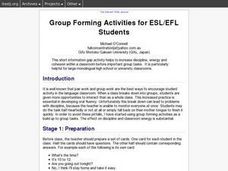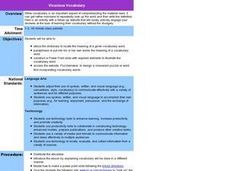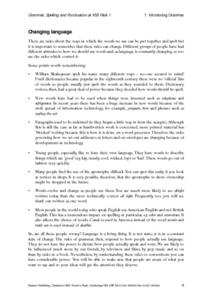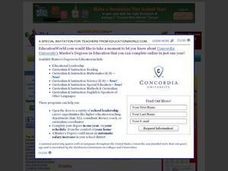Curated OER
Group Forming Activities for ESL/EFL Students
Students increase discipline, energy and cohesion within a classroom to take on important group tasks. Students examine ways of how to pick partners within the boundaries of a classroom. Students validate certain ways to choose thru...
Curated OER
What's The Word?
Students define vocabulary words using print or online dictionaries; create crossword puzzles with those words and definitions; and share their puzzles with peers for review.
Curated OER
Vivacious Vocabulary
Students practice looking up the definitions of words using a dictionary. They put the defintion of the word into their own words. They create a PowerPoint slideshow to show illustrations related to their vocabulary words. Using the...
Curated OER
Looking at Lewis and Clark
Fifth graders review information on Lewis and Clark by using a variety of resources. With partners, they travel between stations researching different information based on the expedition. They check each others work and share it with the...
Curated OER
Spirit in the Night
Eleventh graders explain terms using the CD version of The American Heritage Talking Dictionary. They give and seek information in conversations and in group discussions.
Curated OER
Honoring Abe Lincoln
Students research the life of Abraham Lincoln as a child. They use the information to develop a database. They share the information they collected with the class.
Curated OER
Introducing Grammar: Grammar, Spelling, and Punctuation
Focusing on correct grammar usasge as well as the concept of language evolution, this conventions lesson prompts middle and high schoolers to examine the structure of sentences and word classes (parts of speech). Use the three activites...
Curated OER
Furniture Defined
Students dissect and evaluate traditional definitions of furniture styles. In this furniture characteristics lesson, student learn to classify different styles and types of furniture. Students create furniture sketches.
Curated OER
Mystery Words
In this language arts lesson, 8th graders verify the meaning of a word in its context, even when its meaning is not directly stated. After a class discussion on how to use context clues, students pairs are given a worksheet of "mystery...
Curated OER
Vocabulary Development
By utilizing a graphic organizer called a bubble map, young readers work toward developing their vocabulary. After reading a story, a word that has something to do with the story is put in the middle circle. Then, other words that have...
Curated OER
Etymology
Learners dissect and build words from parts like prefixes, base words, suffixes, and inflectional endings. Etymology skills help us find the meanings of words by identifying the different parts that constitute them. Class members use...
Curated OER
Wrapping It Up
Class members develop their own glossaries for unfamiliar words in each chapter in Elizabeth George Speare’s The Sign of the Beaver. After recording the word, the page number on which the word appears, and its part of speech, they...
Curated OER
Dinosaurs
Second graders use the internet to find information about dinosaurs. Using the information, they complete a database with where the dinosaurs lived, diet, and where bones were found. To end the lesson, they are given criteria and review...
Curated OER
Talking About Your Name in Math Terms
Add imagination and creativity to your math lesson plan. Young mathematicians investigate ways to express their names in mathematical terms. For instance, they can count the number of letters, analyze the geometric shapes of the letters,...
Curated OER
Introduction to the Maya Civilization
Young scholars investigate the Maya civilization. In this Maya civilization lesson, students view a PowerPoint presentation and record notes. Young scholars explore several important landmarks, such as the "Magician's Palace" at Uxmal.
Curated OER
Investigate Career Resources
Tenth graders explore career clusters and select a job to examine. Individually, they research the educational requirements, salary, and job outlook for each resource. They complete a worksheet on careers and indicate the resource used.
Curated OER
Definition Expedition
Students study about three ways to define a term in technical writing, search the Web for scientific text, then copy and paste sections into a Word document. Finally, they use the highlighter feature of Word to highlight examples of...
Curated OER
Proverbs of One World
Bring your class to the computer lab, and have them use the library and online resources to select proverbs related to specified themes. They create a book or bulletin board of proverbs that offer lessons connected to themes of freedom,...
Curated OER
Geographically Speaking
Young scholars play a matching game to reinforce the retention of vocabulary words. In this geography lesson, students watch a PowerPoint to define vocabulary words associated with geography, play a memory game with the words, and...
Curated OER
Synthesis of Information
Locating and synthesizing information is an essential part of the research process but can be overwhelming for many young writers. Eliminate some of the stress and confusion, this resource suggests, by separating these steps. To focus...
Curated OER
Budgeting: You Can't Manage What You Don't Know
Learners discuss budgets. In this mathematics lesson, students watch an episode of Biz Kid$ about budgeting, participate in a guided group discussion, and create a pamphlet to teach others how to budget their money. Extension activities...
Curated OER
Choose Your Words Wisely
Improve word choice! Writers use dictionaries and thesauruses to aid them in choosing exciting words to incorporate in their writing. They rewrite sentences and practice identifying words that can be replaced using a better word....
Curated OER
Planning A Vacation Online
If you could travel anywhere in the United States, where would you go? Use this question to interest your fourth, fifth, and sixth graders as they experiment with Mapquest or other direction-based resources. They choose where they'd like...
Curated OER
Color Mixing
Students experiment with primary colored water to mix new colors. They record new colors on a simple data sheet and share opinions on their work.























